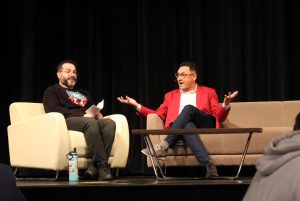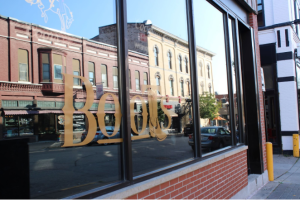News Release: UWL archival holdings reveal Spanish flu message similar to today, stay home
Photo taken from the 1919 yearbook, page 80, courtesy of UWL Murphy Library Special Collections.
La Crosse Normal President Fassett E. Cotton, seated in the center, organized and led the school band. With many men headed to war, there weren’t enough interested from the Normal School in 1918 to form a band, so Cotton recruited young men from Central High School and formed a group of about 40 musicians. Here they are posing for a practice session in the spring on the campus grounds in front of the unfinished physical education building, which was eventually named Wittich Hall. While construction started on the building in 1916, it was stopped during WWI and the building opened in 1920. The university closed in mid-October 1918 due to the Spanish flu epidemic.
April 8, 2020
Schools closed. Church services canceled. UWL students sent home at mid-semester.
This may sound like what we’re going through now with COVID-19, but it actually happened in La Crosse more than 100 years ago as part of the Spanish flu pandemic, which hit the Coulee Region — and the rest of the world — from 1918-20.
“As with other happenings of the past, even though conditions have changed over time, especially in regards to globalization and medical technology, it is still helpful to study the responses to and effects of similar events,” says Laura Godden, a historian and archivist with the UWL Murphy Library Special Collections and Area Research Center.
Godden researched the impact of the Spanish flu in the area for the La Crosse County Historical Society’s Discover the Silent City cemetery tour in 2018.
“Stanley Miller’s dissertation, ‘A History of La Crosse Wisconsin, 1900-1950,’ reports that schools and theatres were closed, and around 93 people died of the flu in the city of La Crosse,” notes Godden. “A local doctor cited in the paper said, ‘this was a low death rate compared with other cities of the size of La Crosse.’” Godden says about 30,000 people lived in La Crosse at the time.
La Crosse fared better than its neighboring counties because of closures and stay-at-home orders. The La Crosse County death rate for the pandemic was only 7.6 per 1,000 residents, compared with Vernon County’s 33.8 and Trempealeau County’s 15.4.
One reason for the area’s relatively low death rate, according to accounts of modern experts Godden researched, were the progressive public health department at the state and local levels.
“Proactive measures to halt all public and private gatherings in a timely manner likely saved many lives,” Godden notes. In 1918 the city of La Crosse even passed a special city ordinance to address the epidemic.

Godden says this historical example can serve as an important reminder of why government and health leaders supported a Safer-at-Home order for COVID-19 — before seeing devastating effects. History also shows many locations experienced a second wave of Spanish flu infections and deaths when relaxing social distancing standards too soon.
“That is something that we should be aware of and potentially brace ourselves for in the future,” Godden says. “Even though a lot has changed in the last 100 years, some of the most important tools for fighting a pandemic are still almost the same: sweeping public health actions and social distancing.”
Studying history, Godden finds, can put an uncertain time into perspective. “It can also help society make more informed decisions and recover psychologically,” she explains. “Just knowing that the world successfully recovered from a large pandemic in the modern era, for example, can provide hope that we can do it again.”
Godden adds that being aware of the long-term effects and how people dealt with them following the end of the Spanish flu outbreak could provide guidance to a smoother COVID-19 recovery.
Godden and her counterpart, UWL Special Collections librarian Paul Beck, are working to document COVID-19 experiences. They are currently preserving images, messages and news articles from both on-campus and local sources. They have also connected with a UWL English professor who is asking her class to keep a journal about their COVID-19 experiences to, hopefully, archive them.
UWL Murphy Library Special Collections has a precedent of archiving student writings about major historic events. For example, there are two collections of student journaling assigned in the 1940s regarding WWII experiences. One was put together by UWL English Professor Emerson Wulling here and the another by UWL English Professor Edgar Knowlton here
Godden notes that other preservation efforts are happening at the La Crosse Public Library Archives, which has launched a communitywide project to preserve COVID-19 experiences via a survey that acts as a journal entry. This effort is being led by Associate Archives Librarian and UWL alum Jenny DeRocher, ’16. Anyone can add to the journaling at: http://archives.lacrosselibrary.org/.
Other impacts of the Spanish flu on campus, 1918-20
• A “La Crosse Tribune” story from Oct. 11, 1918, reports that UWL and K-12 public schools both closed on Oct. 10, 1918. Most of the students from out-of-town packed up belongings and returned home. All classes at UWL were canceled, with the exception of the Student Army Training Corps, whose continuation was prioritized because of WWI. S.A.T.C. continued classes and drills as usual, but they were placed under a temporary quarantine. The closure of K-12 public schools also included UWL’s Campus School, an on-campus training school that served grades K-9.

• A “Racquet” (campus student newspaper) article from Feb. 18, 1919, mentions the deaths of six alumni from the flu. See it.
• A “Racquet” article from April 29, 1919, mentions the death of a student, grimly noting that her death came five months after she was initially stricken. See it here.
• According to the “Racquet”, it wasn’t uncommon at the time for a closure or absence to be referred to as a “flu vacation.” See more.
More than flu
Other dangerous, communicable diseases have disrupted life in La Crosse. Among them:
• In spring 1917, an outbreak of scarlet fever among UWL students led the university to indefinitely discontinue student teaching in the Campus School, the on-campus K-9 school. All UWL students were examined by medical professionals, exposed students were quarantined, and all students were asked not to leave the city during the weekend.
• For at least some years in the 1940s, polio outbreaks delayed the start of K-12 school until the city’s first frost.
• Emerson Elementary, which opened in 1940, was one of 11 statewide designed as an orthopedic school, focusing on providing long-term physical therapy and rehabilitation for the many children suffering from the effects of polio. Children with other disabilities were also served at the school, but polio was the cause of the majority of the orthopedic needs. Emerson had a dedicated medical area, with therapeutic tubs and other specialized equipment staffed by a registered physical therapist. Many community organizations pulled together to open the school, responding to wide-spread polio outbreaks in the ’30s and ’40s that led to the paralysis of many children. With polio almost entirely eradicated after the vaccine became available in 1955, the school transitioned to also serve students without special, medical needs as well.






